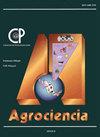基于卷积神经网络的龙舌兰植物密度分析
IF 0.5
4区 农林科学
Q4 AGRICULTURE, MULTIDISCIPLINARY
引用次数: 0
摘要
龙舌兰植物(龙舌兰韦伯)是龙舌兰酒生产链中不可缺少的元素。传统上,人工林监测是人工完成的;然而,掌握龙舌兰库存的准确信息对于规划和估计产量至关重要。在此背景下,提出深度学习算法可以实现对龙舌兰植物的高检出率,从而改善种植园的管理和控制。为此,利用遥控飞机系统捕获的高分辨率RGB航空图像实现并评估了YOLOv4和YOLOv4-tiny卷积算法,以确定龙舌兰植物密度。规划并执行了3个飞行方案,地面采样距离分别为1.10、1.64和2.19 cm pixel-1。创建了数据库,并对算法进行了评估,置信度为0.25,交叉阈值为0.50。结果表明,两种算法的平均准确率为0.99,YOLOv4和YOLOv4-tiny的F1得分分别为0.95和0.96。此外,该方法的检出率(Rc)为99%,精密度(Pr)为90% ~ 92%。在空间分辨率为2.19 cm像素-1的图像中检测龙舌兰分蘖时,观察到算法的性能下降。所实现的YOLO卷积算法被证明具有很强的鲁棒性,能够泛化龙舌兰植物在不同物候阶段的特征,从而实现准确的检测。此外,利用被检测植物的坐标来估计它们之间的距离,最大误差为20 cm。本文章由计算机程序翻译,如有差异,请以英文原文为准。
AGAVE PLANT DENSITY USING CONVOLUTIONAL NEURAL NETWORKS ON AERIAL IMAGERY
Agave plants (Agave tequilana Weber) are an indispensable element in the tequila production chain. Traditionally, plantation monitoring has been done manually; however, having accurate information on agave inventories is crucial for planning and estimating production volume. In this context, it was proposed that deep learning algorithms can achieve high detection rates of agave plants, improving the management and control of plantations. For this purpose, YOLOv4 and YOLOv4-tiny convolutional algorithms were implemented and evaluated using high-resolution RGB aerial images captured by a remotely piloted aircraft system for the determination of agave plant density. Three flight plans were planned and carried out, with ground sampling distances of 1.10, 1.64, and 2.19 cm pixel-1, respectively. The database was created, and the algorithms were evaluated for a confidence level of 0.25 and an intersection threshold over the junction of 0.50. The results showed an average mean accuracy of 0.99 for both algorithms and an F1 score of 0.95 for YOLOv4 and 0.96 for YOLOv4-tiny. Furthermore, a high detection rate (Rc) of 99 % and precision values (Pr) between 90 and 92 % were obtained. A decrease in the performance of the algorithms was observed when detecting agave tillers in images with a spatial resolution of 2.19 cm pixel-1. The implemented YOLO convolutional algorithms proved to be highly robust and able to generalize agave plant characteristics at different phenological stages, allowing accurate detections. In addition, the coordinates of the detected plants were used to estimate the distance between them, with a maximum error of 20 cm.
求助全文
通过发布文献求助,成功后即可免费获取论文全文。
去求助
来源期刊

Agrociencia
农林科学-农业综合
CiteScore
0.50
自引率
33.30%
发文量
51
审稿时长
18-36 weeks
期刊介绍:
AGROCIENCIA is a scientific journal created and sponsored by the Colegio de Postgraduados. Its main objective is the publication and diffusion of agricultural, animal and forestry sciences research results from mexican and foreign scientists. All contributions are peer reviewed. Starting in the year 2000, AGROCIENCIA became a bimonthly and fully bilingual journal (Spanish and English versions in the same issue). Since 2007 appears every month and a half (eight issues per year). In addition to the printed issues, the full content is available in electronic format.
 求助内容:
求助内容: 应助结果提醒方式:
应助结果提醒方式:


